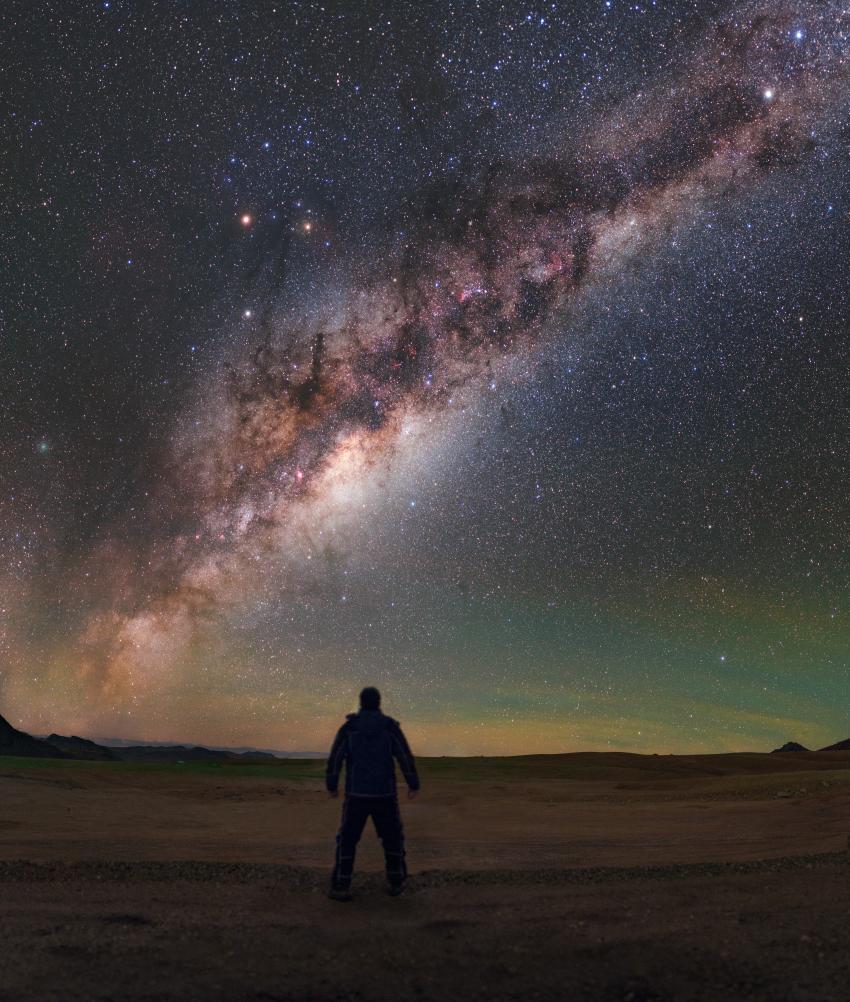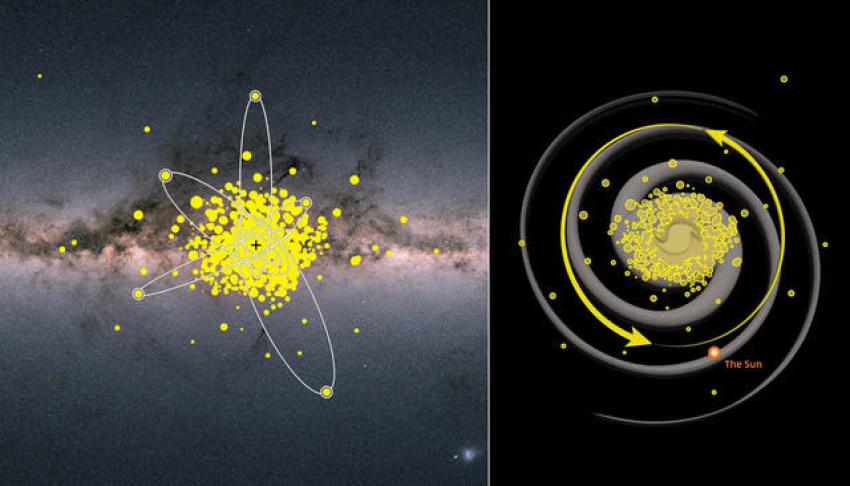An international team of researchers has obtained the largest set of detailed observations yet of the oldest stars in the centre of our Galaxy, the Milky Way. The Pristine Inner Galaxy Survey (PIGS) team finds that this group of stars is slowly spinning around the centre of the Milky Way, despite being thought to have formed in a chaotic fashion. They also seem to spend most of their long lives near the Galactic centre. PIGS team member Dr Anke Arentsen from the University of Cambridge presents the new work this week at the National Astronomy Meeting 2023 at the University of Cardiff.
Some of the stars that were born in the first billion years after the Big Bang are still around today, and they can be used to study what galaxies were like when they were just starting to form. They can be recognised by their pristine chemical composition, mostly being made of hydrogen and helium, with a much lower abundance of heavier elements than younger stars like the Sun. Astronomers typically search for these ancient stars away from the Milky Way disc plane, in the low-density halo around our Galaxy, where they are easier to find.
Galaxy formation models suggest that the very oldest stars are expected to be present in the dense inner parts of the Milky Way. Finding them in this region is challenging as our line of sight to the centre of the Galaxy is blocked by large amounts of interstellar dust, and ancient stars are extremely rare compared to the overwhelming majority of their younger peers.
In the PIGS project, Arentsen and her team employed a special imaging filter on the Canada-France-Hawaii Telescope (CFHT) to efficiently pre-select candidate stars. They were confirmed with spectroscopic observations on the Anglo-Australian Telescope (AAT), resulting in the largest set yet of detailed observations for pristine inner Galaxy stars.
The PIGS observations were then combined with data from the Gaia space mission to study how these ancient stars move through the Milky Way. It turns out that the older the stars are, the more chaotic their motions, but even the very oldest stars found still show some average rotation around the centre of the Galaxy. They also show that many of these stars spend almost all of their lives in the inner Galaxy, inside a sphere that reaches only halfway between the galactic centre and the Sun.
Arentsen comments: “It is exciting to think that we are seeing stars that formed in the earliest phases of the Milky Way, previously largely out of reach. These stars likely formed less than a billion years after the Big Bang, so are relics from the early Universe.
The available data for these ancient objects is growing rapidly. I’m excited to see what we will learn about these first stars to populate our Galaxy in the next few years!”
Media contacts
Dr Robert Massey
Royal Astronomical Society
Tel: +44 (0)20 7292 3979
Mob: +44 (0)7802 877 699
nam-press@ras.ac.uk
Ms Gurjeet Kahlon
Royal Astronomical Society
Mob: +44 (0)7802 877700
nam-press@ras.ac.uk
Ms Megan Eaves
Royal Astronomical Society
nam-press@ras.ac.uk
Science contact
Dr Anke Arentsen
Institute of Astronomy
University of Cambridge
Mob: +44 (0)7751 809150
anke.arentsen@ast.cam.ac.uk
Notes for editors
The NAM 2023 conference is principally sponsored by the Royal Astronomical Society (RAS), the Science and Technology Facilities Council (STFC) and Cardiff University.
About the Royal Astronomical Society
The Royal Astronomical Society (RAS, https://ras.ac.uk), founded in 1820, encourages and promotes the study of astronomy, solar-system science, geophysics and closely related branches of science. The RAS organises scientific meetings, publishes international research and review journals, recognises outstanding achievements by the award of medals and prizes, maintains an extensive library, supports education through grants and outreach activities and represents UK astronomy nationally and internationally. Its more than 4,000 members (Fellows), a third based overseas, include scientific researchers in universities, observatories and laboratories as well as historians of astronomy and others.
Follow the RAS on Twitter (https://twitter.com/royalastrosoc), Facebook (https://facebook.com/royalastrosoc), Instagram (https://instagram.com/royalastrosoc) and YouTube (https://www.youtube.com/channel/UCUZJ5FO9ayrmepOM4FHAASw)
About the Science and Technology Facilities Council
The Science and Technology Facilities Council (STFC) is part of UK Research and Innovation – the UK body which works in partnership with universities, research organisations, businesses, charities, and government to create the best possible environment for research and innovation to flourish. STFC funds and supports research in particle and nuclear physics, astronomy, gravitational research and astrophysics, and space science and also operates a network of five national laboratories, including the Rutherford Appleton Laboratory and the Daresbury Laboratory, as well as supporting UK research at a number of international research facilities including CERN, FERMILAB, the ESO telescopes in Chile and many more.
STFC's Astronomy and Space Science programme provides support for a wide range of facilities, research groups and individuals in order to investigate some of the highest priority questions in astrophysics, cosmology and solar system science. STFC's astronomy and space science programme is delivered through grant funding for research activities, and also through support of technical activities at STFC's UK Astronomy Technology Centre and RAL Space at the Rutherford Appleton Laboratory. STFC also supports UK astronomy through the international European Southern Observatory and the Square Kilometre Array Organisation.
Visit https://stfc.ukri.org/ for more information.
Follow STFC on Twitter: @STFC_Matters
About Cardiff University
Cardiff University is recognised in independent government assessments as one of Britain’s leading teaching and research universities and is a member of the Russell Group - the UK’s most research intensive universities. The 2021 Research Excellence Framework found 90% of the University’s research to be world-leading or internationally excellent. Among its academic staff are two Nobel Laureates, including the winner of the 2007 Nobel Prize for Medicine, Professor Sir Martin Evans. Founded by Royal Charter in 1883, today the University combines impressive modern facilities and a dynamic approach to teaching and research. The University’s breadth of expertise encompasses: the College of Arts, Humanities and Social Sciences; the College of Biomedical and Life Sciences; and the College of Physical Sciences and Engineering. Its University institutes bring together academics from a range of disciplines to tackle some of the challenges facing society, the economy, and the environment. More at www.cardiff.ac.uk



